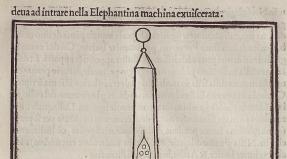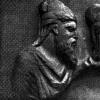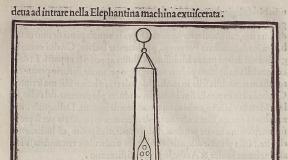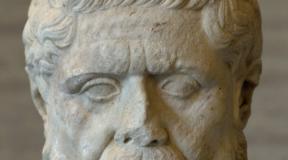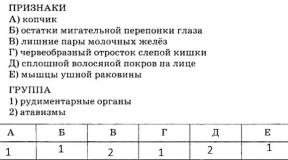Statue of Julius Caesar. Three myths about Julius Caesar. Bust of Julius Caesar, 1st century. according to R. X
Bust of Julius Caesar from the collection of the British Museum. Photograph of Roger Fenton, commissioned by the British Museum. Around 1856 Royal Photographic Society
Julius Caesar is probably the most famous character of ancient history, and indeed of all ancient history. Only Alexander the Great can compete with him. Countless volumes of scientific works, popular biographies and fiction have been written about Caesar. He was played in films by such outstanding actors as John Gielgud, Rex Harrison, Klaus Maria Brandauer and Ciaran Hinds. Around any outstanding historical figure, sooner or later a husk of myths and legends grows. Caesar did not escape this either.
Myth 1. His name was Caius Julius Caesar
Let's start with the name. Caesar, like almost every Roman boy from a good family, had three names: first, praenomen, or personal name (Gaius) - there were very few of them in Ancient Rome, Gaius was one of the most common; secondly, a nomen, or family name (Iulius), and thirdly, a cognomen, originally a nickname with some dictionary meaning, attached to a branch of the clan and becoming hereditary (Cicero - Pea, Naso - Nosy). What the word Caesar meant is unknown. There were many explanations: Caesar himself claimed that it was “elephant” in the “Moorish language,” and Pliny the Elder raised the word to the verb caedo, “to cut, cut,” arguing that the very first Caesar (not ours, but one of his ancestors) was born from a cut uterus, that is, as a result of a procedure later known as a caesarean section. Already thanks to the glory of our Julius Caesar, his cognomen in various forms entered many languages of the world as a synonym for ruler - Caesar, Kaiser, Tsar.
The variant Kai (not Gaius) Julius Caesar has been around in everyday speech for a very long time. It is also found in literature: for example, in the fantastic story “Ghosts” by Turgenev, in “The Golden Calf” by Ilf and Petrov, or in “The White Guard” by Bulgakov. A search through the corpus of Russian literature texts produces 18 results for the query “Caius Julius” versus 21 for “Gai Julius,” almost equally divided. Ivan Ilyich in Tolstoy recalls an example from the “Logic” of the German Kantian philosopher Johann Gottfried Kiesewetter: “Caius is a man, people are mortal, therefore Caius is mortal” (in Kiesewetter: “Alle Menschen sind sterblich, Caius ist ein Mensch, also ist Caius sterblich” ). This is also, of course, “Caius” Julius Caesar. In languages with Latin-based graphics, the variant Caius instead of Gaius also continues to be found - not only in novels, but also, for example, in the books of the modern British popularizer of antiquity Adrian Goldsworthy. This writing is the result not so much of a misunderstanding, but of a peculiar ancient Roman idea of fidelity to tradition.
Although the sounds [k] and [g] have always been different in Latin, this difference was not initially reflected in writing. The reason was that the Etruscan (or some other Northern Italic) alphabet, from which Latin developed, did not have a stop [g]. When the volume of written information began to increase and literacy began to spread (in antiquity, in principle, there were not many free people who could not read and write at least at a primitive level), it became necessary to somehow distinguish between letters denoting dissimilar sounds, and C was attached tail. As linguist Alexander Piperski notes, the letter G is an innovation with a diacritic like the letter E, only more successful from a historical perspective. The letter E, as you know, was popularized by Karamzin, and Roman lovers of antiquities recorded that G was introduced into the alphabet by a certain Spurius Carvilius, a freedman and the first owner of a private elementary school in Rome, in the 3rd century BC. e.
The capital C, representing the sound [g], was often used as the initial of the names Guy and Gnaeus (C and CN, respectively). Such initials were found in dedicatory inscriptions, on tombstones, and in other contexts of increased importance. The Romans were very neurotic about this kind of thing and preferred not to change anything about them. Therefore, in the inscriptions starting from the 2nd century BC. e. we often see the letter G where it should be (for example, in the word AVG, an abbreviation for Augustus), but at the same time the name Guy is abbreviated in the old fashioned way as S. The same with the name Gnei, which is abbreviated as CN (however, the form “Knei” ", as far as I know, is not found anywhere in Russian).
Most likely, it was this ambiguity that caused the split of the popular Roman name into the correct Guy and the erroneous Kai. Kai from Andersen's "The Snow Queen" is most likely not related to Caesar - this is a common Scandinavian name, and there are many other etymological hypotheses about its origin, mainly going back to the Frisian languages.
Myth 2. We know what he looked like
Let's look at some sculptural portraits.
The first is the so-called Tusculan portrait, excavated in 1825 by Lucien Bonaparte (brother of Napoleon I). It is kept in the Museum of Antiquities of Turin. Several more sculptural images, stored in the National Roman Museum, the Hermitage, the New Carlsberg Glyptotek in Copenhagen, etc., belong to the same type.



Tusculan portrait from the Museum of Antiquities of Turin. Dated to 50–40 BC.© Gautier Poupeau / Wikimedia Commons
Copy from a Tusculan portrait. 1st century BC e. - I century AD e.© J. Paul Getty Trust
Copy from a Roman original of the 1st century AD. e. Italy, 16th century© State Hermitage Museum
The second common type of portrait of Caesar is the so-called bust of Chiaramonti (now kept in the Vatican Museums). Adjacent to it is another bust from Turin, sculptures from Parma, Vienna and a number of others.
 Bust of Chiaramonti. 30-20 BC ancientrome.ru
Bust of Chiaramonti. 30-20 BC ancientrome.ru The famous “Green Caesar” is kept in the Berlin Antique Collection.
 "Green Caesar" from the exhibition of the Old Museum. 1st century BC e. Louis le Grand / Wikipedia Commons
"Green Caesar" from the exhibition of the Old Museum. 1st century BC e. Louis le Grand / Wikipedia Commons Finally, in the fall of 2007, another alleged bust of Julius Caesar was raised from the bottom of the Rhone River near the French city of Arles.
 Bust of Julius Caesar from Arles. Approximately 46 BC. e. IRPA / Musée Arles Antique / Wikipedia Commons
Bust of Julius Caesar from Arles. Approximately 46 BC. e. IRPA / Musée Arles Antique / Wikipedia Commons You can also see a good selection of sculptural portraits of Caesar here.
It is noticeable that even within the same type, the portraits are not very similar to each other, and if you compare one type with another, it is not at all clear how they can be the same person. At the same time, ancient Roman portrait sculpture was distinguished by a very high level of realism and consistently achieved portrait resemblance. To be convinced of this, just look at the numerous portraits of later emperors - Augustus, for example, or Marcus Aurelius. They cannot be confused with each other or with anyone else.
What's the matter? The fact is that almost all the ancient sculptural portraits that have come down to us are not signed and their attribution is a highly guess-working matter. Signed portrait images were found only on coins, and Caesar was the first Roman whose image appeared on coins during his lifetime (this happened in 44 BC, and already on March 15 of this year, on the ever-memorable Ides of March, he was killed ). Caesar's denarius, minted by the mint official Marcus Mettius, became the model for all later coins of imperial times.
 Obverse of the denomination of Mar-ka Met-tius with the image of Julius Caesar. 44 BC e. Museum of Fine Arts / Bridgeman Images / Fotodom
Obverse of the denomination of Mar-ka Met-tius with the image of Julius Caesar. 44 BC e. Museum of Fine Arts / Bridgeman Images / Fotodom The 55-year-old Caesar was depicted on the denarius with the realism characteristic of the late Republican era: a very long neck with folds, a protruding Adam's apple, a wrinkled forehead, a thin face, in some versions - wrinkles in the corners of the eyes, a wreath, which, according to rumors, Caesar camouflaged his baldness. But still, a coin is a special genre, and the attribution of a sculptural bust on the basis of a stylized numismatic picture is an unreliable matter. Of course, archaeologists from Arles wanted as many people as possible to know about the Roman bust of outstanding quality - which is undoubtedly a rare find - and this should also help finance the work. And for such a purpose, the “bust of Julius Caesar” is more suitable than the “bust of an unknown Roman.” The same caution must be applied to all other sculptural images of Julius Caesar.
In how the public imagines a character, reputation is often more important than credibility. If you do a Google image search for Emperor Vitellius, the first thing you see is a bust from the Louvre depicting an obese, arrogant man with a triple chin. This correlates well with the image of the emperor, who, according to Suetonius, “was most distinguished by gluttony and cruelty.” But the surviving coins show a completely different face - a man also not thin, but certainly not with a snub nose.


Bust of a man (pseudo-Vitellius). Copy from an earlier sculpture. 16th century© Wikimedia Commons
Denarius of Emperor Vitellius. '69© Wikimedia Commons
Myth 3. He could do several things at once.
Have you ever heard your mother or grandmother say, “Don’t read while you eat, you’re not Gaius (or Caius) Julius Caesar”? At the heart of this warning is the idea that Caesar could multitask and that this kind of multitasking was a unique ability that most people did not have.
Firstly, this meme is most common in Russia. In Western European cultures there is no such stable expression, although the fact itself is known and sometimes mentioned. However, finding it in sources is not so easy. Suetonius says nothing about this in his biography of Caesar. Plutarch, with reference to a certain Oppius, notes that Caesar “during the campaign, he also practiced dictating letters while sitting on a horse, simultaneously employing two or even ... an even larger number of scribes.” This remark is inserted between a mention of his dashing physical dexterity (“He could, by moving his arms back and placing them behind his back, let his horse fly at full speed” - if you think this is not so difficult, I remind you that ancient horsemen did not use stirrups) and a story about the invention of SMS (“They say that Caesar was the first to come up with the idea of conversing with friends about urgent matters through letters, when the size of the city and exceptional busyness did not allow meeting in person”).
 Julius Caesar dictates his sayings. Painting by Pelagio Palagi. 19th century Palazzo del Quirinale/Bridgeman Images
Julius Caesar dictates his sayings. Painting by Pelagio Palagi. 19th century Palazzo del Quirinale/Bridgeman Images Pliny the Elder speaks in somewhat more detail about this feature in his monumental work Natural History. He finds the liveliness of mind that distinguished Caesar unprecedented: “They report that he could write or read and at the same time dictate and listen. He could dictate four letters to his secretaries at a time, and on the most important issues; and if he was not busy with anything else, then seven letters.” Finally, Suetonius, in his biography of Augustus, notes that Julius Caesar, during the circus games, “read letters and papers or wrote answers to them,” for which he was subject to criticism, and Augustus made efforts not to repeat this PR mistake of his adoptive father.
We see that we are not talking about real parallel processing, but (as happens with computers) about quickly switching from one task to another, about competent distribution of attention and prioritization. The life of a public person in antiquity posed tasks to his memory and attention that were incomparable with those that modern people have to solve: for example, any speech, even many hours, had to be learned by heart (opportunities for improvisation, of course, existed, but the general outline in any case had to keep it in my head). Nevertheless, even against this background, Caesar’s abilities made an indelible impression on his contemporaries.
Napoleon Bonaparte, whose desire to imitate and surpass Caesar is well documented, was also famous for his ability to dictate up to seven letters at once and, according to the memoirs of one of his secretaries, Baron Claude François de Meneval, attributed this superpower to his virtuoso mastery of the technique, which in modern managerial jargon is called compartmentalization . “When I want to take my mind off something,” Napoleon said, according to Meneval, “I close the box in which it is stored and open another. The two things never mix and never bother or tire me. When I want to sleep, I close all the drawers." This system of spatial visualization of topics or tasks also dates back to classical antiquity.
Bonus track. Where was Julius Caesar killed?
 Death of Julius Caesar. Painting by Jean Leon Gerome. 1859-1867 Walters Art Museum
Death of Julius Caesar. Painting by Jean Leon Gerome. 1859-1867 Walters Art Museum Caesar was killed on his way to a Senate meeting. This fact, combined with the authority of Shakespeare (who places the assassination scene somewhere near the Capitol - that is, perhaps in the Forum, over the western part of which Capitol Hill rises), gives many the erroneous impression that he was killed directly in the Senate building . The Senate building still stands on the Forum and is even called the Julian Curia. But during the time of Caesar he was not there: the old curia burned down during the unrest that preceded his reign, he ordered a new one to be built, but did not have time to see it (it was completed under Augustus; the building that has survived to this day is even later, from the time of Emperor Diocletian) .
While there was no permanent meeting place, senators gathered wherever they could (this practice has always existed and did not stop after the construction of the curia). On this occasion the place of the meeting was the portico of the newly erected Theater of Pompey; there the conspirators attacked Caesar. Today this point is located in a square called Largo di Torre Argentina. In the 1920s, the ruins of four very old temples from the Republican era were discovered there. Under Augustus, the site of Caesar's murder was walled up as if it were cursed, and a public latrine was built nearby, the remains of which can still be seen today.
Sources
- Gaius Suetonius Tranquillus. The Life of the Twelve Caesars. Divine Julius.
- Caius Pliny Sec. Natural history.
- Plutarch. Comparative biographies. Alexander and Caesar.
- Balsdon J.P.V.D. Julius Caesar and Rome.
- Goldsworthy A. Caesar: Life of a Colossus.
New Haven; London, 2008.
- A Companion to Julius Caesar.
Now we will look into the temples of Rome, wander through the ruins of the Roman Forum and admire other sights.
Let's start with the Pantheon. Translated from other Greek. - Temple of all gods. This is one of the main attractions of Rome, the largest surviving domed structure and until the 19th century. unparalleled. The first building of the Pantheon was built by the consul Marcus Agrippa in 27-25 BC. After the fires in 80 AD. e. and at the beginning of the 2nd century AD. e., the Pantheon was rebuilt. In 126 AD e. Emperor Hadrian modestly left the name of the first builder on its pediment. The inscription reads: “Marcus Agrippa, son of Lucius, elected consul for the third time, erected this.”
According to legend, from this place on July 5, 717 BC. The founder of Rome, Romulus, was ascended to heaven by the god Mars.
The temple is a unique structure and a great engineering achievement of antiquity. The diameter of its dome is 43 m, at the top of the vault there is a round hole with a diameter of 9 m, through which light penetrates inside in the form of a giant cylindrical beam. Apart from the front door and this opening, there are no other light sources.

The interior decoration of the Pantheon was constantly changing. Under Agrippa, in the center of the temple, a huge statue of the deified Julius Caesar was installed, and on the sides there were statues of Mars, Venus, Saturn, Neptune and other gods.

On November 1, 609, the pagan temple was consecrated as the Christian Church of St. Mary and the Martyrs.

Below the Madonna of the Rock statue is the tomb of Raphael (1483-1520). The great master indicated the burial place in the Pantheon and how it should be decorated in his dying will. The sarcophagus was installed by order of Pope Gregory XVI. The inscription reads: “Here lies Raphael, whom Nature feared would be defeated forever and die with him.” To the left of the sculpture is a bust of Raphael made of black marble (created in 1833 by the sculptor Giuseppe Fabris).

The second king of Italy, Umberto I, is buried in a red marble sarcophagus.

Fresco from a painting by an unknown artist (1686 from Bari) “Madonna with a Belt and St. Nicholas”. “There is an Orthodox tradition that on the third day after the burial, the Mother of God appeared to the Apostle Thomas and threw Her belt from Heaven to him as a consolation,” because he was late for the burial and cried for a long time near the coffin.

"The Annunciation" This fresco is believed to have been painted by Melozzo (Ambrosi) da Forli during his Roman period (1480-84)

Tomb of the first king of Italy, Victor Emmanuel II. (died 1878). "PADRE DELLA PATRIA" - Father of the Fatherland.
We now enter the church of San Silvestro in Capite. "Capite", lat. (Capute) - head, is in the name of the church, because it houses a relic, the head of John the Baptist.

Interior decoration. The basilica is decorated with marble, richly decorated with paintings by famous painters, gilding, statues, frescoes and relics.

The main relic of the church is the head (part of the skull without jaw) of John the Baptist. It is located in the chapel, to the right of the entrance to the church. To doubt the authenticity of this relic is considered blasphemy, but to this day the question remains, because Catholicism believes that the original head is kept in this church, Islamic tradition believes that it is in the Umayyad mosque in Damascus. This relic is also worshiped in Amiens (France), brought there from the fourth crusade, in Turkish Antioch and in one of the monasteries of Armenia.

The figure of the Mother of God mourning Christ.
Let's take a look at another church - the Basilica of San Petro in Vincoli.

In the background of the interior you can see the main altar, in the lower part of which the chains of St. Apostle Peter are stored in the ark (hence the name of the temple). The first part of the chains is from the Jerusalem prison (42), the second part is Roman, under Nero, from the Mamertine prison (64). The temple contains the tombs of the artist Antonio Pogliolo and the powerful Pope Julius II,
In the left nave, a bas-relief depicting death with white wings and a scythe attracts attention.

As the guide explained, she was placed here so that she would not be forgotten as an eternal companion of earthly life. Maybe she's right. The Italians, not without a certain amount of irony, call this work “The White-Winged Lady with a Scythe.”

The walls of the temple are decorated with works of great masters.
We're on the street again. To the left of the Curia Julius you see several columns. This is one of the oldest temples - the Temple of Saturn, or rather what remains of it, eight columns, six of gray granite on the facade and two of red on the sides.

It is believed that the temple was built in 489 BC. e. after the victory over the Etruscan kings in honor of the god Saturn, whom the Romans considered their patron. Inside the temple stood a statue of Saturn made of gold and ivory. After the completion of agricultural work, the Saturnalia holiday began in the last week of December. The statue was taken out of the temple for the procession, sacrifices were made to the god Saturn, then a general feast and fun began. Perhaps this is where the tradition of organizing a harvest festival in modern times came from.

General view of the ruins of the Imperial Forums.

The remains of the temple in the form of three columns located in the Forum of Julius Caesar.

Caesar's Forum was built in 54-46. BC e. (the photo shows its remains).

The monument to Julius Caesar is a bronze copy of the statue located in the Capitol. Recently installed. The abbreviation on the pedestal is lat. S.P.Q.R. - Senatus Populusque Romanus (Senate and Citizens of Rome), often found in many historical places of the city.
Gaius Julius Caesar was born on July 13 (12), 100 (102) BC. e. Killed March 15, 44 BC e. Ancient Roman statesman and politician, dictator, commander, writer. At different times, married three times. Children: Julia Caesaris (daughter from her first marriage) and Ptolemy XV Caesarion (doubtedly an illegitimate son from a relationship with Cleopatra). With his conquests, Caesar expanded the borders of the Roman power to the British Isles. He also carried out very important government reforms, changing the calendar, which we now call the Julian. The month in which he was born is named after his name - July, and in honor of his successor, adopted by the will of Octavian's nephew Augustus - the month of August. The life and work of Julius Caesar is described in detail in various sources, including in his own “Notes” (memoirs), as well as in biographies, characteristics and reviews of him (sometimes of different polarities) written by his contemporaries. Among them is the ancient Roman politician and philosopher, a brilliant orator, Cicero. So I suggest you familiarize yourself with these materials. The Russian words “tsar”, “Caesar” and the German “Kaiser” were subsequently derived from the name of Caesar.

In the center is the church of Santa Maria in Cosmedin. Built on the ruins of the Temple of Hercules in the 8th century. The elegant belfry decorating the city is visible from afar, built in the 12th century.

Excavations of the remains of a temple complex from the times of the Roman Republic in Torre Argentina. To this day it has not been established to whom these four temples are dedicated and so far they have been named conventionally - A, B, C and D. It is known that in the 1st century BC. e. Around these temples there were public buildings - a circus, a theater, the Curia of Pompeii, etc.

The area of the column is so named because the marble Column of Marcus Aurelius (41.5 m) is located on it.

The column is hollow, inside it there is a spiral staircase with 190-200 steps. Previously, a sculpture of Marcus Aurelius was installed on top of the column in honor of the victory over the Germans and Sarmatians in the Marcomannic War. The entire surface of the column is richly decorated with bas-reliefs depicting scenes from this war. The small holes that are visible along the column are windows for lighting the stairs inside the column.

In the 16th century, the statue of Marcus Aurelius was lost and in 1589, at the direction of Pope Sixtus V, a bronze statue of the Apostle Paul was installed in its place. St. Paul is often depicted with a sword in his hand, because before he met Jesus Christ, he was a Pharisee and took part in the persecution of the first Christians.

Street of the Imperial Forums.

Once upon a time, life was in full swing here and these forums were filled with crowds of Romans. Here their fates and the fates of other peoples were decided. In the photo on the left is the Temple of Antoninus and Faustina. Built in 141 AD. e. by order of Emperor Antoninus Pius in honor of his deceased wife Faustina.

In the foreground is part of the surviving five-story Roman residential building "Insula Araceli", 2nd century. n. e., in the northern part of the Capitoline Hill, discovered during excavations during the construction of the Vittoriano monument. In one of the upper floors, during the Middle Ages, a church was built.

View of the city from the ledge of the Vittoriano monument.

Vittoriano (Italian: Vuttoriano) is a monument in honor of the first king of united Italy. Built from 1885 to 1935. In the center of the monument, on a ledge, is a twelve-meter bronze equestrian statue of the king. Below it stands a statue of the goddess Roma. Even lower is the grave of the Unknown Soldier who died in the First World War, the so-called “Altar of the Fatherland” and a permanent Guard of Honor. The Romans do not like this structure because it contrasts with the surrounding buildings and ironically call it: - “Typewriter*,” “Wedding Cake,” “False Jaws,” etc.
To be continued...
Address: Italy, Rome, Roman Forum
Main attractions: Temple of Venus
Coordinates: 41°53"38.3"N 12°29"06.3"E
Short description
Thanks to the tireless work of archaeologists and historians, more and more historical and architectural monuments are being born in Rome, one after another. Surprisingly, from almost any high-rise building in Rome you can see the ruins of some complex dating back to the heyday of the Roman Empire.
Bird's eye view of Caesar's Forum
One of these attractions, discovered by scientists relatively recently, is the Forum of Caesar, which, by the way, is considered the first imperial forum erected on the territory of the modern capital of Italy.
The Forum of Caesar, despite its small size (170x75 meters), is quite popular among tourists. This is due, first of all, to the history of its construction. And the name of Gaius Julius Caesar is known to almost every civilized and more or less literate inhabitant of our vast planet. Only the ruins of the complex, which included numerous statues, a basilica and a temple, have survived to this day.

View of the Temple of Venus
Construction of Caesar's Forum
As we know from history, Gaius Julius Caesar was the greatest and fearless commander, a warrior who knew no fear, and fought with his legion on the sites of the bloodiest battles. In addition, Caesar had an innate talent as a strategist and politician, thanks to which he became the emperor of the Roman Empire, who was respected not only by aristocrats, but also by the people. In 54 BC, Caesar decided to build his own forum.
To do this, he entrusted Marcus Tulius Cicero, who was known among the people not only as a philosopher, orator and politician, capable of causing delight and worship among the public with his speeches, a huge sum for those times: 60 million sesterces for the purchase of land. Some sources contain information that the amount for purchasing a plot for the construction of Caesar's forum was much higher, amounting to approximately 100 million sesterces.

Gaius Julius Caesar was not a narcissistic and selfish ruler, like Nero, for example, and the new Forum of Caesar was supposed to be built as part of the legendary Roman Forum. Forum, which was considered the main square of ancient Rome.
In 48 BC, the famous battle between the troops of Julius Caesar and the army of his former friend Pompey took place. Then the enemy managed to lure Caesar into a trap, and a decisive battle could not be avoided. Pompey's troops were several times larger than Caesar's 30,000-strong army, and the future emperor put everything on the line, including his life. In the morning, shortly before the battle, Gaius Julius Caesar made a vow to his patroness Venus, from whom, according to legend, the Julian family descended, that if his army defeated the army of his former friend, who basely betrayed him in his time, he would immediately give the order to build on his forum of the Temple in honor of the great Venus. In fairness, it is worth noting that in 48 BC. construction of the forum had just begun.

Those who are at least a little familiar with the history of the Roman Empire and the “eternal city” know that the decisive battle began at Pharsala. It is not known what played a decisive role in those days - the help of Venus or the talent of Caesar, but Pompey with his superior army was completely defeated and was forced to flee to Egypt. In this country, where Cleopatra and Caesar were revered, Pompey was stabbed to death as soon as he set foot on the shore. The battle of Pharsala became a landmark, and in the Forum of Caesar it was immediately decided to erect a temple of Venus, which became, perhaps, the central building of the entire complex. In the temple of Venus itself, according to documents compiled by ancient chroniclers, there was a huge statue of Venus and Caesar himself on horseback. They were made of bronze and plated with gold. The emperor did not forget about his beloved Cleopatra: her huge portrait also adorned one of the walls of the Temple of Venus.
In addition to this majestic structure, which delighted the guests of Rome for several centuries, the Silver Basilica was built, which served as an exchange where money was exchanged. Amazing, isn't it? Both censors and exchanges appeared in ancient Rome. The archaeologists who showed the world Caesar's forum wrote in their reports that they found the remains of shops and even workshops that they managed to fit into such a small space. Alas, to this day, they, naturally, have not survived, since for the most part they were made not of stone, but of short-lived wood. Another interesting fact is that most of the buildings were erected from Caesar’s personal trophies, which he received during the war with the Gauls.

Caesar's Forum: history and our days
Shortly after the assassination of Caesar, his forum fell into disrepair and only came to life again in 113 AD thanks to reconstruction carried out on the orders of Trajan. The inauguration of the new emperor took place in the Temple of Venus, in honor of which a new column was erected there, called Trajan's Column. Surprisingly, thanks to the study of ancient documents, even the exact date of the second opening ceremony of Caesar's forum is known - May 12, 113.
Nowadays, numerous tourists can see that excavations on the territory of Caesar's Forum do not stop. Thanks to them, light is shed on the events that occurred during the heyday of the Roman Empire. Our contemporaries have not forgotten the name of, perhaps, the greatest emperor, Gaius Julius Caesar. In his honor, not so long ago, a bronze copy of the emperor’s statue was installed on the territory of the ruins of the Forum of Caesar, the original of which can be seen in the Capitol.
Last week, French archaeologists made a sensational discovery in the bed of the Rhone River, near the city of Arles. A bust of Gaius Julius Caesar was found. Scientists believe that this is the only portrait made during his lifetime, unlike all still known images of Caesar's head, which were created at a later time. The surprise was that the commander and emperor looked different than we imagined him to be.
“They say he was tall, fair-skinned, well-built, his face was slightly full, his eyes were black and lively. He was in excellent health,” reports the ancient Roman writer and historian Suetonius(c. 70-130/40), describing Gaius Julius Caesar. As secretary to Emperor Hadrian, Suetonius could draw his information from a reliable archival source. “He looked after his body too carefully, and not only cut and shaved, but also plucked his hair, and many reproached him for this. His disgraceful baldness was unbearable to him, as it often brought ridicule from ill-wishers. Therefore, he usually combed his thinning hair from the crown on his forehead; that is why he accepted with the greatest pleasure and took advantage of the right to constantly wear a laurel wreath.”
The French researcher of antiquity was confident that he had found a bust of a man whose portrait was once left to us by Suetonius. Luke Long(Luc Long), who made the discovery near Arles: “I recognized him immediately.”
This discovery can already rightfully be considered paramount, given that only 20 or 25 images of the Roman commander and dictator have survived since antiquity. However, the discovery will become a real sensation if researchers manage to confirm that the bust from Arles is the only lifetime image of Caesar.
It is possible that the bust was sculpted between 49 and 46 BC. e. Consequently, it turns out to be older than the head of Caesar from Tusculum, which is usually dated to the 44th year, the year of Caesar's death, or somewhat later.
Most likely, the image was made in the year 46, when, as is commonly believed, the city of Arles was founded. Then Caesar was 54 years old, two years earlier he defeated Pompey at the Battle of Pharsalus, captured Alexandria, conceived a son with Queen Cleopatra, and - in April 46 - in the province of Africa defeated the troops of senators Metellus Scipio and Cato.
He was at the height of his power when he began to satisfy the demands of his veterans by awarding them land. Parts of his sixth legion settled in the colony of Arelate, today's city of Arles.
The image from the Rhône shows a well-lived man who has already experienced something in his lifetime. Caesar ruled Gaul from 58, when he became governor of the province. In Gaul, he saw war, experienced defeat and repeatedly looked death in the eye, and walked countless kilometers. Many wrinkles, a massive head, thin hair, all this makes us attribute the found portrait to a number of images of high-ranking figures from the times of the Roman Republic, who, unlike their Greek models, do little to idealize the character, trying to convey his individual features.
Despite the incredible abundance of wrinkles on the face, Hansgerd Hellenkemper(Hansgerd Hellenkemper), director of the Roman-Germanic Museum in Cologne, wants to see a portrait of Caesar in the find. In an interview with Welt, he noted that the face is “fabulously preserved” and bears “republican features,” but the artifact, perhaps, is more likely to be dated to the period of the Augustan Principate. Colleagues from Arles, in his opinion, not being experts in the field of Roman portraiture, were mistaken. He considers it possible to date the find only on the basis of features characteristic of this style. However, one thing is already clear to Hellenkämper: “A pan-European discussion will flare up around this portrait.”
Dresden historian of antiquity and biographer of Caesar Martin Jene(Martin Jehne) calls the Rhone find a sensation and cites it as a sensational example of improving the methods of underwater archeology. At the same time, he criticizes the conclusions drawn by Luc Long based on his discovery. He says "that the bust was thrown into the river after the assassination of Caesar. Then it was considered bad manners to be his follower."
This interpretation, according to Jene, is possible because just a few days after the assassination of Caesar on the Ides of March (March 15), 44 supporters of the dictator and his assassins were looking for a compromise. They were not pursued. In the short period of time between the announcement of the death and the political truce, no community began

would be from iconoclasm, given that it consisted mostly of Caesar's veterans. Most likely they would have taken up arms and joined the armed ranks of Caesar's supporters. After all, they owed their commander not only the founding of the colony, but also the lands on which they lived.
The found bust of Caesar can be more likely explained by other historical reasons. After his victory over the sons of Pompey at Munda in Spain in the year 45, the Senate decided to hold a triumph. Caesar became dictator for life. His statues were to be erected in all cities, as the historian Appian reports.
This means that in the months between Caesar's return to Rome and his assassination, a large number of statues must have been removed. Sources say that after the Ides of March, several images in Rome were withdrawn for alteration and their further production ceased. The image of Caesar from Tusculum may have appeared in this connection. To do this, there must have been samples, which probably included the image from the Rhone. This would allow the Rhone find to be considered “part of the world cultural heritage,” believes Luc Long.
True, the question remains why only one lifetime portrait of Caesar has been found so far. This is probably also due to big politics. In the East, Caesar's killers launched a big war against his supporters and are unlikely to have treated the statues of the dictator with care. Later, after his bloody victory, Caesar's adopted son Octavian had little interest in viewing his reign within the framework of ancestral tradition. Finally, he openly demonstrated his monarchical ambitions, expressed according to the Eastern model. Augustus, who positioned himself as the first citizen - princeps, consciously wanted to stand out against this background and in his propaganda refrained from expressing the cult of ancestors.
It was only at the end of the 1st century AD that Caesar began to be revered as the founder of the Empire and statues and monuments were erected to him accordingly. On them, his appearance was given by noble features and finely crafted hair. Previous surviving images of Caesar have little in common with the stern features of the man found at the bottom of the Rhone.
A courageous man and seducer of women, Gaius Julius Caesar is a great Roman commander and emperor, famous for his military exploits, as well as for his character, because of which the name of the ruler became a household name. Julius is one of the most famous rulers who was in power in Ancient Rome.
The exact date of birth of this man is unknown; historians generally believe that Gaius Julius Caesar was born in 100 BC. At least, this is the date used by historians in most countries, although in France it is generally accepted that Julius was born in 101. A German historian who lived in the early 19th century was confident that Caesar was born in 102 BC, but Theodor Mommsen's assumptions are not used in modern historical literature.
Such disagreements among biographers are caused by ancient primary sources: ancient Roman scholars also disagreed about the true date of Caesar’s birth.
The Roman emperor and commander came from a noble family of patrician Julians. Legends say that this dynasty began with Aeneas, who, according to ancient Greek mythology, became famous in the Trojan War. And Aeneas’s parents are Anchises, a descendant of the Dardanian kings, and Aphrodite, the goddess of beauty and love (according to Roman mythology, Venus). The story of the divine origin of Julius was known to the Roman nobility, because this legend was successfully spread by the relatives of the ruler. Caesar himself, whenever the opportunity presented itself, liked to remember that there were Gods in his family. Scientists hypothesize that the Roman ruler comes from the Julian family, who were the ruling class at the beginning of the founding of the Roman Republic in the 5th-4th centuries BC.

Scientists also put forward various assumptions about the emperor's nickname “Caesar”. Perhaps one of the Julius dynasty was born by caesarean section. The name of the procedure comes from the word caesarea, which means “royal”. According to another opinion, someone from a Roman family was born with long and unkempt hair, which was denoted by the word “caeserius”.
The family of the future politician lived in prosperity. Caesar's father Gaius Julius served in a government position, and his mother came from the noble Cotta family.

Although the commander's family was wealthy, Caesar spent his childhood in the Roman region of Subura. This area was full of women of easy virtue, and also mostly poor people lived there. Ancient historians describe Suburu as a dirty and damp area, devoid of intelligentsia.
Caesar's parents sought to give their son an excellent education: the boy studied philosophy, poetry, oratory, and also developed physically and learned equestrianism. The learned Gaul Mark Antony Gniphon taught the young Caesar literature and etiquette. Whether the young man studied serious and exact sciences, such as mathematics and geometry, or history and jurisprudence, biographers do not know. Guy Julius Caesar received a Roman education; from childhood, the future ruler was a patriot and was not influenced by fashionable Greek culture.
Around 85 BC. Julius lost his father, so Caesar, as the only man, became the main breadwinner.
Policy
When the boy was 13 years old, the future commander was elected priest of the main God in Roman mythology, Jupiter - this title was one of the main posts of the then hierarchy. However, this fact cannot be called the pure merits of the young man, because Caesar’s sister, Julia, was married to Marius, an ancient Roman commander and politician.
But in order to become a flamen, according to the law, Julius had to get married, and the military commander Cornelius Cinna (he offered the boy the role of priest) chose Caesar’s chosen one - his own daughter Cornelia Cinilla.

In 82, Caesar had to flee Rome. The reason for this was the inauguration of Lucius Cornelius Sulla Felix, who began a dictatorial and bloody policy. Sulla Felix asked Caesar to divorce his wife Cornelia, but the future emperor refused, which provoked the anger of the current commander. Also, Gaius Julius was expelled from Rome because he was a relative of Lucius Cornelius' opponent.
Caesar was deprived of the title of flamen, as well as his wife and his own property. Julius, dressed in poor peasant clothes, had to escape from the Great Empire.
Friends and relatives asked Sulla to have mercy on Julius, and because of their petition, Caesar was returned to his homeland. In addition, the Roman emperor did not see the danger in the person of Julius and said that Caesar was the same as Mari.

But life under the leadership of Sulla Felix was unbearable for the Romans, so Gaius Julius Caesar went to the Roman province located in Asia Minor to learn military skills. There he became an ally of Marcus Minucius Thermus, lived in Bithynia and Cilicia, and also participated in the war against the Greek city of Metilene. Participating in the capture of the city, Caesar saved the soldier, for which he received the second most important award - the civil crown (oak wreath).
In 78 BC. Residents of Italy who disagreed with Sulla’s activities tried to organize a rebellion against the bloody dictator. The initiator was the military leader and consul Marcus Aemilius Lepidus. Mark invited Caesar to take part in the uprising against the emperor, but Julius refused.
After the death of the Roman dictator, in 77 BC, Caesar tries to bring to justice two of Felix's henchmen: Gnaeus Cornelius Dolabella and Gaius Antonius Gabrida. Julius appeared before the judges with a brilliant oratorical speech, but the Sullans managed to avoid punishment. Caesar's accusations were written down in manuscripts and circulated throughout Ancient Rome. However, Julius considered it necessary to improve his oratory skills and went to Rhodes: A teacher, rhetorician Apollonius Molon lived on the island.

On his way to Rhodes, Caesar was captured by local pirates who demanded a ransom for the future emperor. While in captivity, Julius was not afraid of the robbers, but, on the contrary, joked with them and told poems. After freeing the hostages, Julius equipped a squadron and set off to capture the pirates. Caesar was unable to bring the robbers to trial, so he decided to execute the offenders. But due to the gentleness of their character, Julius initially ordered them to be killed, and then crucified on the cross, so that the robbers would not suffer.
In 73 BC. Julius became a member of the highest college of priests, which was previously ruled by the brother of Caesar's mother, Gaius Aurelius Cotta.
In 68 BC, Caesar married Pompey, a relative of Gaius Julius Caesar's comrade-in-arms and then bitter enemy, Gnaeus Pompey. Two years later, the future emperor receives the position of Roman magistrate and is engaged in the improvement of the capital of Italy, organizing celebrations, and helping the poor. And also, having received the title of senator, he appears at political intrigues, which is how he gains popularity. Caesar participated in the Leges frumentariae ("corn laws"), under which the population purchased grain at a reduced price or received it for free, and also in 49-44 BC. Julius carried out a number of reforms
Wars
The Gallic War is the most famous event in the history of Ancient Rome and the biography of Gaius Julius Caesar.
Caesar became proconsul, by this time Italy owned the province of Narbonese Gaul (the territory of present-day France). Julius went to negotiate with the leader of the Celtic tribe in Geneva, since the Helvetii began to move due to the invasion of the Germans.

Thanks to his oratory, Caesar managed to persuade the leader of the tribe not to set foot on the territory of the Roman Empire. However, the Helvetii went to Central Gaul, where the Aedui, allies of Rome, lived. Caesar, who was pursuing the Celtic tribe, defeated their army. At the same time, Julius defeated the German Suevi, who attacked the Gallic lands located on the territory of the Rhine River. After the war, the emperor wrote an essay on the conquest of Gaul, “Notes on the Gallic War.”
In 55 BC, the Roman military commander defeated the incoming Germanic tribes, and later Caesar himself decided to visit the territory of the Germans.

Caesar was the first commander of Ancient Rome who made a military campaign on the territory of the Rhine: Julius’s detachment moved along a specially built 400-meter bridge. However, the army of the Roman commander did not stay on the territory of Germany, and he attempted to make a campaign against the possessions of Britain. There, the military leader won a series of crushing victories, but the position of the Roman army was unstable, and Caesar had to retreat. Moreover, in 54 BC. Julius is forced to return to Gaul in order to suppress the uprising: the Gauls outnumbered the Roman army, but were defeated. By 50 BC, Gaius Julius Caesar had restored territories belonging to the Roman Empire.
During military operations, Caesar showed both strategic qualities and diplomatic skill; he knew how to manipulate the Gallic leaders and instill contradictions in them.
Dictatorship
After seizing Roman power, Julius became a dictator and took advantage of his position. Caesar changed the composition of the Senate, and also transformed the social structure of the empire: the lower classes stopped being driven to Rome, because the dictator canceled subsidies and reduced bread distributions.
Also, while in office, Caesar was engaged in construction: a new building named after Caesar was erected in Rome, where the Senate meeting was held, and an idol of the patroness of love and the Julian family, the Goddess of Venus, was erected in the central square of the capital of Italy. Caesar was named emperor, and his images and sculptures adorned the temples and streets of Rome. Every word of the Roman commander was equated to law.
Personal life
In addition to Cornelia Zinilla and Pompeii Sulla, the Roman emperor had other women. Julia's third wife was Calpurnia Pizonis, who came from a noble plebeian family and was a distant relative of Caesar's mother. The girl was married to the commander in 59 BC, the reason for this marriage is explained by political goals, after the marriage of his daughter, Calpurnia’s father becomes consul.
If we talk about Caesar’s sex life, the Roman dictator was loving and had relationships with women on the side.
 Women of Gaius Julius Caesar: Cornelia Cinilla, Calpurnia Pisonis and Servilia
Women of Gaius Julius Caesar: Cornelia Cinilla, Calpurnia Pisonis and Servilia There are also rumors that Julius Caesar was bisexual and engaged in carnal pleasures with men, for example, historians recall his youthful relationship with Nicomedes. Perhaps such stories took place only because they tried to slander Caesar.
If we talk about the famous mistresses of the politician, then one of the women on the side of the military leader was Servilia - the wife of Marcus Junius Brutus and the second bride of the consul Junius Silanus.
Caesar was condescending towards Servilia's love, so he tried to fulfill the wishes of her son Brutus, making him one of the first persons in Rome.

But the most famous woman of the Roman emperor is the Egyptian queen. At the time of the meeting with the ruler, who was 21 years old, Caesar was over fifty: a laurel wreath covered his bald head, and there were wrinkles on his face. Despite his age, the Roman emperor conquered the young beauty, the happy existence of the lovers lasted 2.5 years and ended when Caesar was killed.
It is known that Julius Caesar had two children: a daughter from his first marriage, Julia, and a son, born from Cleopatra, Ptolemy Caesarion.
Death
The Roman emperor died on March 15, 44 BC. The cause of death was a conspiracy of senators who were indignant over the dictator's four-year rule. 14 people took part in the conspiracy, but the main one is considered to be Marcus Junius Brutus, the son of Servilia, the emperor’s mistress. Caesar loved Brutus infinitely and trusted him, placing the young man in a superior position and protecting him from difficulties. However, the devoted republican Marcus Junius, for the sake of political goals, was ready to kill the one who endlessly supported him.
Some ancient historians believed that Brutus was the son of Caesar, since Servilia had a love relationship with the commander at the time of the future conspirator’s conception, but this theory cannot be confirmed by reliable sources.

According to legend, the day before the conspiracy against Caesar, his wife Calpurnia had a terrible dream, but the Roman emperor was too trusting, and also recognized himself as a fatalist - he believed in the predetermination of events.
The conspirators gathered in the building where the Senate meetings were held, near the Theater of Pompeii. No one wanted to become the sole killer of Julius, so the criminals decided that each would inflict one single blow on the dictator.

The ancient Roman historian Suetonius wrote that when Julius Caesar saw Brutus, he asked: “And you, my child?”, and in his book he writes the famous quote: “And you, Brutus?”
Caesar's death hastened the fall of the Roman Empire: the people of Italy, who valued Caesar's government, were furious that a group of Romans had killed the great emperor. To the surprise of the conspirators, the only heir was named Caesar - Guy Octavian.
The life of Julius Caesar, as well as stories about the commander, are replete with interesting facts and mysteries:
- The month of July is named after the Roman emperor;
- Caesar's contemporaries claimed that the emperor suffered from epileptic seizures;
- During gladiator fights, Caesar constantly wrote something on pieces of paper. One day the ruler was asked how he manages to do two things at once? To which he replied: “Caesar can do three things at the same time: write, watch, and listen.”. This expression has become popular; sometimes Caesar is jokingly called a person who takes on several tasks at the same time;
- In almost all photographic portraits, Gaius Julius Caesar appears before the audience wearing a laurel wreath. Indeed, in life the commander often wore this triumphal headdress, because he began to go bald early;

- About 10 films were made about the great commander, but not all are biographical in nature. For example, in the series "Rome" the ruler remembers the uprising of Spartacus, but some scholars believe that the only connection between the two commanders is that they were contemporaries;
- Phrase "I came, I saw, I conquered" belongs to Gaius Julius Caesar: the commander pronounced it after the capture of Turkey;
- Caesar used a code for secret correspondence with generals. Although the “Caesar cipher” is primitive: the letter in the word was replaced by the symbol that was to the left or to the right in the alphabet;
- The famous Caesar salad is named not after the Roman ruler, but after the chef who came up with the recipe.
Quotes
- "Victory depends on the valor of the legions."
- “When one loves, call it what you want: slavery, affection, respect... But this is not love - love is always reciprocated!”
- “Live in such a way that your friends will be bored when you die.”
- “No victory can bring as much as one defeat can take away.”
- “War gives the conquerors the right to dictate any conditions to the conquered.”


